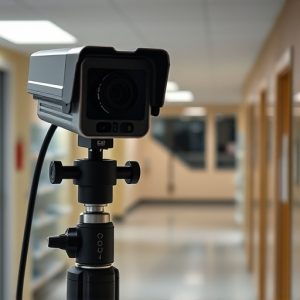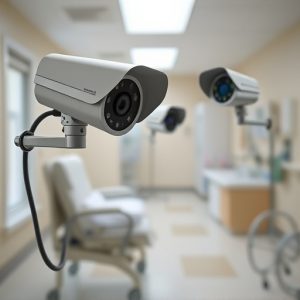Balancing Safety and Privacy with Camera Surveillance in Assisted Living
Cameras in nursing homes serve as a critical tool for enhancing resident safety and well-being by p…….
Cameras in nursing homes serve as a critical tool for enhancing resident safety and well-being by providing comprehensive surveillance, deterring neglect or abuse, and offering evidence should such issues arise. These intelligent cameras not only ensure that care practices are followed but also provide reassurance to residents and their families about the documentation of incidents, thus fostering a safer living environment. Strategic placement is vital to balance privacy with oversight, capturing both private rooms and shared spaces where social engagement and mobility are essential for quality of life. The latest camera technology includes data analysis capabilities that offer alerts for unusual activities or potential hazards, enhancing the responsiveness of caregivers and enabling immediate assistance. To maintain this balance between safety and privacy, facilities must implement comprehensive policies regarding data protection, consent, and ethical surveillance practices, ensuring legal compliance and respecting residents' dignity. Staff training on privacy matters and ethical practices is crucial to uphold trust within the community. Advanced features like motion detection and alert systems are recommended to optimize data management. The overarching aim is to use cameras for nursing homes as a safety resource rather than a tool for overbearing surveillance, thereby fostering a secure environment that respects residents' rights and autonomy. Regular audits ensure that the use of these cameras adheres to the facilities' commitment to ethical surveillance and maintaining residents' trust.
Assisted living facilities are tasked with safeguarding the well-being of residents, a responsibility that has increasingly intertwined with technological advancements. The role of surveillance, particularly through cameras for nursing homes, is a multifaceted issue touching on resident safety, privacy, and ethical considerations. This article dissects these aspects, beginning with an evaluation of how surveillance cameras can enhance the lives and security of residents in assisted living settings. It then delves into best practices for the implementation of such systems, ensuring they complement, rather than compromise, the privacy and dignity of the elderly. Finally, it addresses the ethical framework necessary to navigate this evolving landscape, underscoring the importance of striking a balance between protection and respect for individual autonomy.
Evaluating the Role of Cameras for Nursing Homes in Enhancing Resident Safety and Well-being
Cameras for nursing homes serve a multifaceted role in enhancing resident safety and well-being. These devices are integral to monitoring environments where elderly individuals reside, offering round-the-clock surveillance that can deter neglect or abuse, and providing critical evidence should such issues arise. The visual data captured by these cameras facilitates the continuous assessment of care practices, ensuring that staff interactions align with the highest standards of resident support. Moreover, the presence of cameras can offer peace of mind to residents and their families, knowing that any potential incidents will be documented, thereby promoting a safer and more secure living environment. The strategic placement of cameras within these facilities is crucial for capturing both communal areas and private rooms, balancing privacy with the need for oversight in shared spaces. This dual approach allows for the protection of residents’ personal spaces while maintaining a watchful eye on common areas where social interactions and mobility are key to their quality of life.
Furthermore, advancements in technology have led to the development of cameras for nursing homes that not only record but also analyze data, providing alerts when unusual activities or potential hazards are detected. These intelligent systems can enhance the responsiveness of caregivers and trigger immediate assistance, potentially preventing falls or other incidents that could compromise a resident’s health and safety. The integration of these smart surveillance solutions is not just about safeguarding against negative outcomes; it also contributes to a positive living experience by ensuring that staff are attentive and responsive to residents’ needs. As such, the role of cameras in nursing homes extends beyond security, becoming a vital tool for promoting an environment where safety, well-being, and dignity are paramount.
Best Practices for Implementing Surveillance Systems in Assisted Living Facilities
When implementing surveillance systems in assisted living facilities, it is imperative to prioritize resident privacy and safety concurrently. The use of cameras for nursing homes should be strategic and aligned with best practices to ensure that monitoring is conducted ethically and effectively. One key practice involves placing cameras discreetly in common areas where they can deter theft or violence without intruding on residents’ personal spaces. These cameras should be high-definition and capable of capturing clear footage to aid in the swift resolution of any incidents. Additionally, real-time monitoring capabilities allow staff to respond promptly to alerts, ensuring a timely intervention when necessary.
Another crucial aspect is the implementation of a robust data protection policy that adheres to all relevant laws and regulations. This policy should outline how footage is stored, who has access to it, and under what circumstances it can be reviewed. Staff training on privacy concerns and proper handling of surveillance footage is essential to maintain trust among residents and their families. Furthermore, the system should incorporate features like motion detection and alert systems to minimize the amount of data recorded and stored, thus reducing storage needs and potential misuse. By carefully considering these elements, assisted living facilities can create a secure environment for both residents and staff, using cameras for nursing homes as a tool for safety rather than surveillance.
Addressing Privacy Concerns and Ethical Considerations in Assisted Living Surveillance
In the realm of assisted living, the integration of surveillance systems, particularly cameras for nursing homes, raises significant privacy and ethical concerns. It is imperative to balance the need for security and safety with residents’ right to privacy. The deployment of such systems should be guided by clear policies that outline when, how, and why footage may be reviewed or accessed. These policies must prioritize consent from residents or their representatives, ensuring they are fully aware of what data is being collected and how it will be utilized. Moreover, the storage, handling, and sharing of captured images should adhere to stringent security measures to prevent unauthorized access or breaches that could compromise residents’ dignity and privacy.
Ethical considerations extend beyond privacy to include the dignity and autonomy of assisted living residents. The use of cameras for nursing homes must be justified by a genuine intention to enhance safety, well-being, and care. It is crucial to avoid overreliance on surveillance as a panacea for all challenges faced in these facilities. Transparency and accountability are key; there should be a clear protocol for handling any incidents detected by surveillance, with the primary focus being on the well-being of the residents. Regular audits and reviews of the surveillance system’s implementation can help ensure that it serves its intended purpose without infringing on residents’ rights or creating an environment of mistrust among staff and residents alike.


